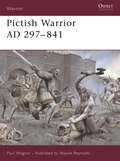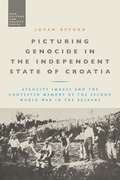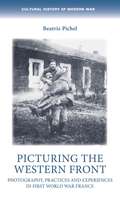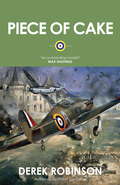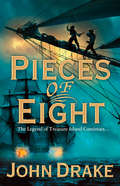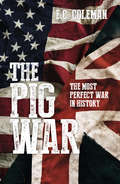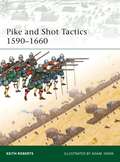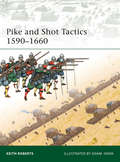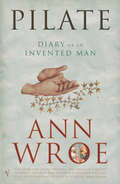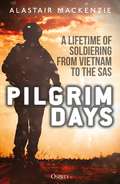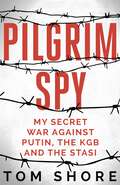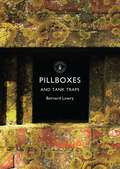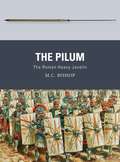- Table View
- List View
Pickett's Charge--The Last Attack at Gettysburg: Includes Pickett's Charge--the Last Attack At Gettysburg By Earl J. Hess And Pickett's Charge In History And Memory By Carol Reardon (Civil War America)
by Earl J. HessSweeping away many of the myths that have long surrounded Pickett's Charge, Earl Hess offers the definitive history of the most famous military action of the Civil War. He transforms exhaustive research into a moving narrative account of the assault from both Union and Confederate perspectives, analyzing its planning, execution, aftermath, and legacy.
Pictish Warrior AD 297-841 (Warrior)
by Angus Konstam Wayne Reynolds Paul WagnerFirst mentioned by name in AD 297, the Picts inhabited Northern Britain from the end of the 3rd century AD to the 9th. They rose to power in the devastation following Emperor Septimus Severus's repression of the Caledonians in AD 208, and dominated Northern Britain for over 500 years, before vanishing mysteriously. The Picts represent a high point of Celtic civilisation, remaining free and unconquered beyond the borders of the Roman world, and rising to become the first barbarians to form a recognisable 'nation'. This title takes a detailed look at their origins, and examines Pictish heroic and warrior society, covering education and training, appearance and equipment, the status of women, and the experience of battle.
Pictish Warrior AD 297-841 (Warrior #50)
by Angus Konstam Paul WagnerFirst mentioned by name in AD 297, the Picts inhabited Northern Britain from the end of the 3rd century AD to the 9th. They rose to power in the devastation following Emperor Septimus Severus's repression of the Caledonians in AD 208, and dominated Northern Britain for over 500 years, before vanishing mysteriously. The Picts represent a high point of Celtic civilisation, remaining free and unconquered beyond the borders of the Roman world, and rising to become the first barbarians to form a recognisable 'nation'. This title takes a detailed look at their origins, and examines Pictish heroic and warrior society, covering education and training, appearance and equipment, the status of women, and the experience of battle.
Picturing Genocide in the Independent State of Croatia: Atrocity Images and the Contested Memory of the Second World War in the Balkans (War, Culture and Society)
by Jovan ByfordPicturing Genocide in the Independent State of Croatia examines the role which atrocity photographs played, and continue to play, in shaping the public memory of the Second World War in the countries of the former Yugoslavia. Focusing on visual representations of one of the most controversial and politically divisive episodes of the war -- genocidal violence perpetrated against Serbs, Jews, and Roma by the pro-Nazi Ustasha regime in the Independent State of Croatia (1941-1945) -- the book examines the origins, history and legacy of violent images. Notably, this book pays special attention to the politics of the atrocity photograph. It explores how images were strategically and selectively mobilized at different times, and by different memory communities and stakeholders, to do different things: justify retribution against political opponents in the immediate aftermath of the war, sustain the discourses of national unity on which socialist Yugoslavia was founded, or, in the post-communist era, prop-up different nationalist agendas, and 'frame' the Yugoslav wars of the 1990s.In exploring this hitherto neglected aspect of Yugoslav history and visual culture, Jovan Byford sheds important light on the intricate nexus of political, cultural and psychological factors which account for the enduring power of atrocity images to shape the collective memory of mass violence.
Picturing Genocide in the Independent State of Croatia: Atrocity Images and the Contested Memory of the Second World War in the Balkans (War, Culture and Society)
by Jovan ByfordPicturing Genocide in the Independent State of Croatia examines the role which atrocity photographs played, and continue to play, in shaping the public memory of the Second World War in the countries of the former Yugoslavia. Focusing on visual representations of one of the most controversial and politically divisive episodes of the war -- genocidal violence perpetrated against Serbs, Jews, and Roma by the pro-Nazi Ustasha regime in the Independent State of Croatia (1941-1945) -- the book examines the origins, history and legacy of violent images. Notably, this book pays special attention to the politics of the atrocity photograph. It explores how images were strategically and selectively mobilized at different times, and by different memory communities and stakeholders, to do different things: justify retribution against political opponents in the immediate aftermath of the war, sustain the discourses of national unity on which socialist Yugoslavia was founded, or, in the post-communist era, prop-up different nationalist agendas, and 'frame' the Yugoslav wars of the 1990s.In exploring this hitherto neglected aspect of Yugoslav history and visual culture, Jovan Byford sheds important light on the intricate nexus of political, cultural and psychological factors which account for the enduring power of atrocity images to shape the collective memory of mass violence.
Picturing the Western Front: Photography, practices and experiences in First World War France (Cultural History of Modern War)
by Dr Beatriz PichelBetween 1914 and 1918, military, press and amateur photographers produced thousands of pictures. Either classified in military archives specially created with this purpose in 1915, collected in personal albums or circulated in illustrated magazines, photographs were supposed to tell the story of the war. Picturing the Western Front argues that photographic practices also shaped combatants and civilians’ war experiences. Doing photography (taking pictures, posing for them, exhibiting, cataloguing and looking at them) allowed combatants and civilians to make sense of what they were living through. Photography mattered because it enabled combatants and civilians to record events, establish or reinforce bonds with one another, represent bodies, place people and events in imaginative geographies and making things visible, while making others, such as suicide, invisible. Photographic practices became, thus, frames of experience.
Picturing the Western Front: Photography, practices and experiences in First World War France (Cultural History of Modern War)
by Dr Beatriz PichelBetween 1914 and 1918, military, press and amateur photographers produced thousands of pictures. Either classified in military archives specially created with this purpose in 1915, collected in personal albums or circulated in illustrated magazines, photographs were supposed to tell the story of the war. Picturing the Western Front argues that photographic practices also shaped combatants and civilians’ war experiences. Doing photography (taking pictures, posing for them, exhibiting, cataloguing and looking at them) allowed combatants and civilians to make sense of what they were living through. Photography mattered because it enabled combatants and civilians to record events, establish or reinforce bonds with one another, represent bodies, place people and events in imaginative geographies and making things visible, while making others, such as suicide, invisible. Photographic practices became, thus, frames of experience.
Piece of Cake (R.A.F. Quartet #1)
by Derek RobinsonFrom the Phoney War of 1939 to the Battle of Britain in 1940, the pilots of Hornet Squadron learn their lessons the hard way. Hi-jinks are all very well on the ground, but once in a Hurricane's cockpit, the best killers keep their wits close. Newly promoted Commanding Officer Fanny Barton has a job on to whip the Hornets into shape before they face the Luftwaffe's seasoned pilots. And sometimes Fighter Command, with its obsolete tactics and stiff doctrines, is the real menace. As with all Robinson's novels, the raw dialogue, rich black humour and brilliantly rendered, adrenalin-packed dogfights bring the Battle of Britain, and the brave few who fought it, to life.
A Piece of Cake (A Roald Dahl Short Story)
by Roald DahlA Piece of Cake is a short, gripping story of life in wartime from Roald Dahl, the master of the shocking tale.In A Piece of Cake, Roald Dahl, one of the world's favourite authors, tells the horrific story of a pilot whose plane crashes in the desert. A Piece of Cake is taken from the short story collection Over to You, which includes nine other dramatic and terrifying tales of life as a wartime fighter pilot, and is drawn from Dahl's own experiences during the Second World War.This story is also available as a Penguin digital audio download read by Julian Rhind-Tutt.Roald Dahl, the brilliant and worldwide acclaimed author of Charlie and the Chocolate Factory, James and the Giant Peach, Matilda, and many more classics for children, also wrote scores of short stories for adults. These delightfully disturbing tales have often been filmed and were most recently the inspiration for the West End play, Roald Dahl's Twisted Tales by Jeremy Dyson. Roald Dahl's stories continue to make readers shiver today.
Pieces of Eight
by John DrakeThe second in the rip-roaring adventure series of ‘Treasure Island’ prequels for fans of ‘Pirates of the Caribbean’
The Pieces of Us
by Caroline Montague'Tender and moving' Jane Bailey'A beautiful portrait of love and loss, and of hope in adversity' Sarah SteeleMarina and Hugh were once madly in love. But after the loss of their beautiful little daughter, grief has created a distance between them that feels impossible to bridge. Marina knows leaving Italy is the only way they will be able to move on, but Thorncliffe Hall, Hugh's family home in England, is so grey and unwelcoming.Just when life feels like it may never regain colour, Marina and Hugh come across a striking china coffee pot in a London shop window, adorned with a fox flying through the night sky. The coffee pot comes attached with a mystery, one that is connected with Hugh's own family many years ago.By digging into the past, Marina is about to discover a story far beyond her wildest dreams. But will the past help her heal the present?A heartwrenching, utterly unforgettable story for fans of Sally Page and Amanda Prowse.***Praise for Caroline Montague's spellbinding stories'All all the ingredients for a Sunday night TV drama' Prue Leith 'Enthralling... snared us in an ever-tightening circle of love and despair, secrets and forgiveness' Joanna Lumley'Thoroughly engrossing' Julian Fellowes, creator of Downton Abbey'Enthralling and wonderfully romantic, with gorgeous characters, this is perfect to curl up with and get lost in' Katie Fforde 'A moving, sweeping saga of love and loss' Dinah Jefferies
The Pig War: The Most Perfect War in History
by E C ColemanWith a plot to grace any comic opera, the 1859-72 'Pig War' broke out when an American living on a quietly disputed small island in the Gulf of Georgia shot a British pig he found rooting up his garden produce. The authorities on nearby Vancouver Island and the military leadership of the adjacent Washington Territory both felt they had good reasons to escalate a trivial incident into a full-blown war between the United States and Great Britain. Soon, American soldiers found themselves looking down the barrels of the Royal Navy cannon. Whilst both the British and the Americans continued to threaten and bluster, Royal Marines and US soldiers settled down on the island to a round of social events, including sports days, combined dinners and even summer balls. Despite the outbreak of the American Civil War, and British intervention on the Confederate side, the hot-heads were restrained and, eventually, it was decided that the problem should become one of the earliest examples of international arbitration. The German Kaiser was brought in and - from the British point of view - came to the wrong decision. Set against the framework of US attempts to gain control of the whole North American continent, The Pig War is a highly readable account of a little-known episode in Anglo-American history.
Pigeon Pie (Mitford, Nancy Ser.)
by Nancy MitfordSet at the outbreak of World War II, Lady Sophia Garfield dreams of becoming a beautiful spy but manages not to notice a nest of German agents right under her nose. Until the murder of her maid and the kidnapping of her beloved bulldog force them on her attention, with heroic and absurd results.One of Mitford's earliest novels and written before Christmas 1939, Pigeon Pie is delivered with a touch lighter than that of her later masterpieces but no less entertaining. This comedy combines glamour, wit, and a fiendishly absurd plot into an irresistible literary confection.'This sparking and deliciously acid commentary of the social world.' - The Scotsman
Pike and Shot Tactics 1590–1660 (Elite #(PDF))
by Keith Roberts Mr Adam HookThroughout the 17th century large parts of Europe were depopulated during the wide-ranging and savage wars of religion and dynasty, involving all of the major powers. This was therefore a key period in the development of 'modern' infantry tactics, such as the use of pole-arms and muskets together hence the popular expression 'pike and shot'. These infantry tactics involved different national schools on thought and practice, and were tested bloodily in great battles. This title covers the Dutch-Spanish wars of independence, The Thirty Years' War and the English Civil Wars.
Pike and Shot Tactics 1590–1660 (Elite #179)
by Keith Roberts Mr Adam HookThroughout the 17th century large parts of Europe were depopulated during the wide-ranging and savage wars of religion and dynasty, involving all of the major powers. This was therefore a key period in the development of 'modern' infantry tactics, such as the use of pole-arms and muskets together hence the popular expression 'pike and shot'. These infantry tactics involved different national schools on thought and practice, and were tested bloodily in great battles. This title covers the Dutch-Spanish wars of independence, The Thirty Years' War and the English Civil Wars.
Pilate: The Biography Of An Invented Man
by Ann WroeAlthough very little is known for certain about Pontius Pilate, the man who crucified Christ, this has not stopped writers in every age from imagining his life. In this extraordinary book, Ann Wroe recounts the lives of all our Pilates; among them the glittering medieval tyrant, devoted to gambling and getting around the law, and the wriggling modern pragmatist, whose dilemma over Jesus has been described by Tony Blair as 'a timeless parable of political life'. This is also the story of the man Pilate might have been; and the man who mirrors us. Ann Wroe shows how, in his struggles with fate and free will, Pilate's story has also become the story of ourselves.
Pilgrim Days: From Vietnam to the SAS
by Alastair MacKenzie'We are the Pilgrims, master; we shall go, Always a little further; it may be, Beyond that last blue mountain barred with snow.' If there was ever anyone who went a little further, a little beyond, it was Alastair MacKenzie. In a career spanning 30 years, MacKenzie served uniquely with the New Zealand Army in Vietnam, the British Parachute Regiment, the British Special Air Service (SAS), the South African Defence Force's famed ParaBats, the Sultan of Oman's Special Forces and a host of private security agencies and defence contractors. MacKenzie lived the soldier's life to the full as he journeyed 'the Golden Road to Samarkand'. This extraordinary new work from the author of Special Force: The Untold Story of 22nd Special Air Service Regiment (SAS) vividly documents, in a detail that stuns, the experience of infantry combat in Vietnam, life with the Paras, the tempo of selection for UK Special Forces, covert SAS operations in South Armagh and SAS Counter Terrorist training on the UK mainland, vehicle-mounted Pathfinder Brigade insertions into Angola and maritime counter-terrorism work in Oman.
Pilgrim Days: From Vietnam to the SAS
by Alastair MacKenzie'We are the Pilgrims, master; we shall go, Always a little further; it may be, Beyond that last blue mountain barred with snow.' If there was ever anyone who went a little further, a little beyond, it was Alastair MacKenzie. In a career spanning 30 years, MacKenzie served uniquely with the New Zealand Army in Vietnam, the British Parachute Regiment, the British Special Air Service (SAS), the South African Defence Force's famed ParaBats, the Sultan of Oman's Special Forces and a host of private security agencies and defence contractors. MacKenzie lived the soldier's life to the full as he journeyed 'the Golden Road to Samarkand'. This extraordinary new work from the author of Special Force: The Untold Story of 22nd Special Air Service Regiment (SAS) vividly documents, in a detail that stuns, the experience of infantry combat in Vietnam, life with the Paras, the tempo of selection for UK Special Forces, covert SAS operations in South Armagh and SAS Counter Terrorist training on the UK mainland, vehicle-mounted Pathfinder Brigade insertions into Angola and maritime counter-terrorism work in Oman.
Pilgrim Spy: My secret war against Putin, the KGB and the Stasi
by Tom ShoreThis is one of the great untold stories of the twentieth century.It is a first-hand account of a mission by an SAS soldier sent behind the Iron Curtain by MI6 to find someone who didn't necessarily want to be found and how, on a follow-up mission, he found himself manoeuvring against a mysterious KGB officer - one Major Vladimir Putin and a murder plot by Kremlin hardliners. If the plot had succeeded, it would have given the Russians the excuse they were looking for to roll out the tanks across East Germany, the Berlin Wall would not have fallen - and the map of Europe would look very different today.It tells of roof top chases, the interrogation of terrorists to gain vital information, a beautiful, East German female (who he suspected of being a Stasi spy), betrayal by people he trusted, an escape through forests pursued by enemy agents and ending in a climactic gun battle at Colditz castle, formerly used by the Soviets as a psychiatric hospital to detain dissidents.In James Bond novels, it is MI6 operators who carry out this type of work, but in reality, when facing a committed foe in an isolated and deadly environment, the intelligence agencies call upon members of the British Special Forces. This is the first insider account of how UK operators working undercover, do what needs to be done in order to protect the UK's interests abroad - revealing their hidden hand in world events.
Pillaging The Empire: Piracy In The Americas, 1500-1750
by Kris LaneBetween 1500 and 1750, European expansion and global interaction produced vast wealth. As goods traveled by ship along new global trade routes, piracy also flourished on the world’s seas. Pillaging the Empire tells the fascinating story of maritime predation in this period, including the perspectives of both pirates and their victims. Brushing aside the romantic legends of piracy, Kris Lane pays careful attention to the varied circumstances and motives that led to the rise of this bloodthirsty pursuit of riches, and places the history of piracy in the context of early modern empire building. This second edition of Pillaging the Empire has been revised and expanded to incorporate the latest scholarship on piracy, maritime law, and early modern state formation. With a new chapter on piracy in East and Southeast Asia, Lane considers piracy as a global phenomenon. Filled with colorful details and stories of individual pirates from Francis Drake to the women pirates Ann Bonny and Mary Read, this engaging narrative will be of interest to all those studying the history of Latin America, the Atlantic world, and the global empires of the early modern era.
Pillaging The Empire: Piracy In The Americas, 1500-1750
by Kris LaneBetween 1500 and 1750, European expansion and global interaction produced vast wealth. As goods traveled by ship along new global trade routes, piracy also flourished on the world’s seas. Pillaging the Empire tells the fascinating story of maritime predation in this period, including the perspectives of both pirates and their victims. Brushing aside the romantic legends of piracy, Kris Lane pays careful attention to the varied circumstances and motives that led to the rise of this bloodthirsty pursuit of riches, and places the history of piracy in the context of early modern empire building. This second edition of Pillaging the Empire has been revised and expanded to incorporate the latest scholarship on piracy, maritime law, and early modern state formation. With a new chapter on piracy in East and Southeast Asia, Lane considers piracy as a global phenomenon. Filled with colorful details and stories of individual pirates from Francis Drake to the women pirates Ann Bonny and Mary Read, this engaging narrative will be of interest to all those studying the history of Latin America, the Atlantic world, and the global empires of the early modern era.
Pillboxes and Tank Traps (Shire Library)
by Bernard LowryWith invasion a very real threat, in 1940 Great Britain began a huge military construction programme designed to stop an invading army in its tracks. Around vulnerable coastlines, and inland, thousands of pillboxes, anti-tank barriers and other obstacles were erected to defend against attacks from sea and sky. Though many of these structures were dismantled in the wake of the Second World War, the coast and even some inland areas still boast a wealth of fascinating remains; in this fully illustrated introduction, fortifications authority Bernard Lowry guides the inquiring reader in identifying these remaining defensive structures and explains their seemingly 'random' placement across the British landscape.
The Pilum: The Roman Heavy Javelin (Weapon)
by Peter Dennis M. C. BishopA heavy javelin, normally used as a shock weapon immediately before contact, the pilum was designed with a particular speciality: it could penetrate a shield and carry on into the individual behind it. Relying on mass rather than velocity, at short range a volley of pila had much the same effect on a charging enemy as musketry would in later periods. The design was not uniform, with a wide diversity of types throughout the developmental history of the weapon, but for more than four centuries it remained a vital part of the arsenal of weapons at the disposal of the Roman legionary. Drawing upon recent major finds in the Iberian Peninsula and the Balkans, as well as written records and rigorous scientific analysis, this enthralling study lifts the veil on the evolving nature of the pilum, the Roman heavy javelin that helped to conquer the known world.
The Pilum: The Roman Heavy Javelin (Weapon #55)
by Peter Dennis M. C. BishopA heavy javelin, normally used as a shock weapon immediately before contact, the pilum was designed with a particular speciality: it could penetrate a shield and carry on into the individual behind it. Relying on mass rather than velocity, at short range a volley of pila had much the same effect on a charging enemy as musketry would in later periods. The design was not uniform, with a wide diversity of types throughout the developmental history of the weapon, but for more than four centuries it remained a vital part of the arsenal of weapons at the disposal of the Roman legionary. Drawing upon recent major finds in the Iberian Peninsula and the Balkans, as well as written records and rigorous scientific analysis, this enthralling study lifts the veil on the evolving nature of the pilum, the Roman heavy javelin that helped to conquer the known world.
Pin-Up Fireman (Wild Heat #4)
by Vonnie DavisThe heat is on… Book 4 in the ‘Wild Heat’ series – the hottest new firefighter series of the year!

